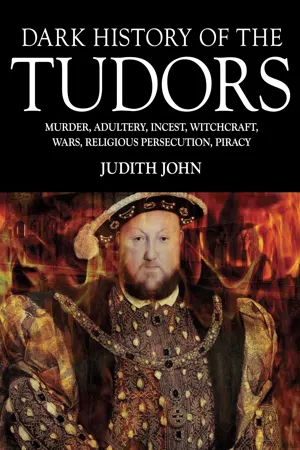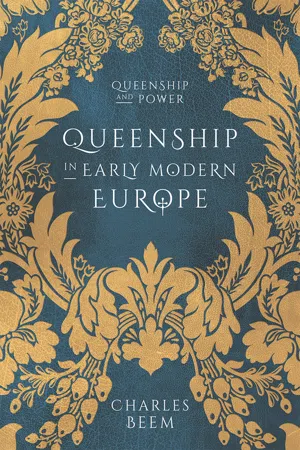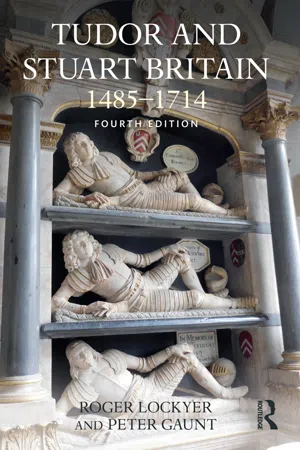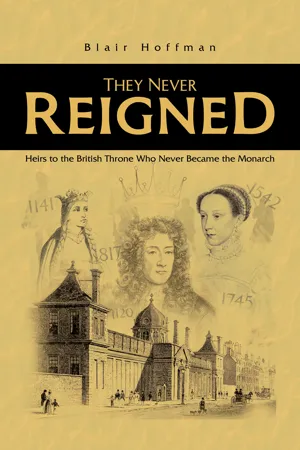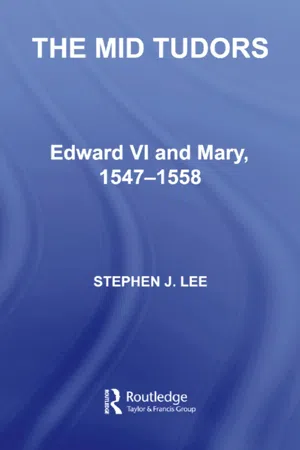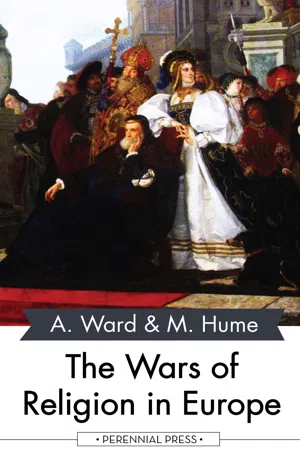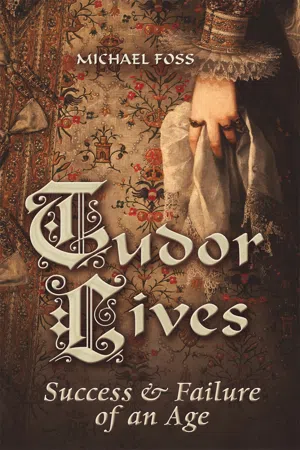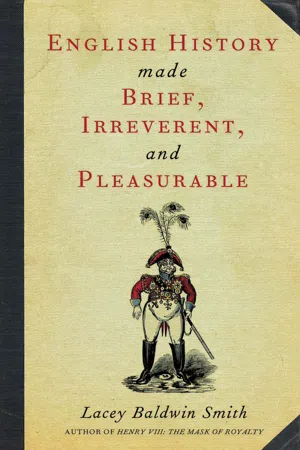History
Mary I of England
Mary I of England, also known as "Bloody Mary," was the queen of England from 1553 to 1558. She was the daughter of Henry VIII and Catherine of Aragon. Mary is remembered for her efforts to restore Roman Catholicism in England, which led to the persecution of Protestants and earned her the nickname "Bloody Mary." Her reign was marked by religious turmoil and political challenges.
Written by Perlego with AI-assistance
Related key terms
Related key terms
1 of 4
Related key terms
1 of 3
10 Key excerpts on "Mary I of England"
- eBook - ePub
Dark History of the Tudors
Murder, adultery, incest, witchcraft, wars, religious persecution, piracy
- Judith John(Author)
- 2014(Publication Date)
- Amber Books Ltd(Publisher)
Pictured here looking pensive, the first crowned Queen of England had much to endure throughout her life, from being disowned by her father at the age of 17 to suffering several false pregnancies during her miserable marriage to Philip II of Spain.V
TUDORS
MARY, MARY, QUITE CONTRARY
To great adulation, Mary I began her reign as the beloved saviour of traditional religion in England. However, her five-year rule would see deaths, famine, war, martyrs and rebellion that led to England’s first Queen being one of the most abhorred English monarchs in history.‘If God be for us, who can be against us?’ – MARY IM ary’s determination to restore the Tudor line to its rightful religion saw her overturn reforms set in motion by her father and brother, make an ill-advised foreign marriage, suffer illness and false pregnancies and leave her country worse off for her efforts. Bloody Mary would go from being hailed as the nation’s redeemer to dying estranged from her husband and sister, childless and reviled.Henry’s Heir
Being the firstborn child of the King was never easy for a daughter. Mary suffered more than most as she went from being the adored heir to the English throne to an unwanted bastard while still a teenager. This tumultuous childhood affected her deeply and conferred on Mary the character traits that would mar her later reign. As Henry’s first surviving child, Mary was revered and adored. As a daughter, she was tolerated until a son came along. When Catherine of Aragon was Queen, Mary was the beloved successor to the throne. When Anne Boleyn was Queen, Mary was declared baseborn and feared for her life.Brought up a devout Catholic, Mary later had to deny her beliefs and turn to the Church of England to appease her father, the man who had discarded her as illegitimate and destroyed her much-loved mother’s happiness. The pattern of her life was to lose anything of importance. It was a pattern that would reoccur even when she was Queen. Mary was never able to shake off the bonds of blood, which affected her both physically and mentally throughout her chaotic life. - eBook - ePub
- Charles Beem(Author)
- 2019(Publication Date)
- Bloomsbury Academic(Publisher)
For centuries, historians followed John Foxe’s lead, who created the enduring image of “Bloody Mary” persecuting Protestants in the face of an inevitable rise of a Protestant England. By the later twentieth century, the historiographical certainties of the Whig interpretation of British history, which identified an inevitable trend towards a Protestant polity and parliamentary supremacy, gave way to more nuanced and document-based assessments of Mary’s reign. 40 Nevertheless, scholars such as Geoffrey Elton, David Loades, and John Guy have considered Mary’s performance as queen sterile, lackluster, and unproductive. 41 With the more recent rise of feminist-inspired approaches to queenship studies, however, scholars such as Judith Richards and Sarah Duncan have focused on how Mary adapted the roles and functions of both English kingship and queenship in the execution of her office. Mary also recreated the dichotomy between royal spectacle and queenly piety practiced by her grandmothers, Isabella of Castile and Elizabeth of York, and her mother, Catherine of Aragon. Like all these queens, Mary recognized the political value of royal splendor, presiding over an extravagant court and wearing sumptuous clothing and jewels as she hosted a variety of musical and dramatic productions over the course of her reign. At the same time Mary lived an ostentatiously pious life, viewing her coronation, the first of its kind, as a form of wedding to her realm, a representational device that reconciled the anointing of a now genderless body politic of kingship within the body natural of a woman. 42 For representational purposes, Mary advertised herself as England’s first virgin queen since Edith, the consort of the saintly eleventh-century Edward the Confessor - eBook - ePub
Tudor and Stuart Britain
1485-1714
- Roger Lockyer, Peter Gaunt(Authors)
- 2018(Publication Date)
- Routledge(Publisher)
She was intelligent, powerful and courageous, actively leading a campaign of Catholicization that was often innovative, energetic and quite successful, it has been argued. More broadly, some go on to claim that in 1553 Catholicism was far stronger, at least at parish level, and Protestantism not as advanced and entrenched as the older interpretations allowed; on those grounds, they suggest that had Mary lived longer or had she had a child and left a Catholic heir her dream of bringing England back to Rome and restoring Catholicism might have succeeded and been cemented. But even some of the revisionists who are generally more sympathetic to Mary find that part of the story unconvincing and concede that, for all the vibrancy of late medieval and early Tudor Catholicism, that time had passed and that by the 1550s it was too late to reverse the Reformation. On that reading her early and childless death, knowing that the throne would pass to her Protestant half-sister – while never formally nominating her, near the end she sent a message to Elizabeth acknowledging that she would succeed – ended a hopeless quest. Early on the morning of 17 November Mary I died at St James’s Palace. On the other side of the river Cardinal Pole was also lying ill in his palace at Lambeth. He survived Mary by only a few hours. The Catholic reaction had ended as abruptly as it began. - eBook - ePub
They Never Reigned
Heirs to the British Throne Who Never Became the Monarch
- Blair Hoffman(Author)
- 2023(Publication Date)
- Austin Macauley Publishers(Publisher)
Meanwhile, the Tudor dynasty in England continued. When Henry VIII died in 1547, his son by his third wife, Jane Seymour—Henry’s only son to survive infancy—became King Edward VI at the age of nine years. Edward was doomed to die at fifteen. Edward’s half-sister, Mary—Henry VIII’s daughter by his first wife, Catherine of Aragon—succeeded Edward as Mary I. Mary, a Catholic, tried to reverse the English Reformation and restore Catholicism to its accustomed position in England. She succeeded temporarily, but in the process, she oversaw the burning at the stake of hundreds of unrepentant Protestants charged with heresy—most prominently Thomas Cranmer, Henry VIII’s Archbishop of Canterbury, one of the leaders of the English Reformation and the man who had declared invalid the marriage between Mary’s mother and Henry. Her brutal suppression of Protestantism earned her the sobriquet by which she is known to this day: Bloody Mary. After a five-year reign, Mary died at the age of 42, only a few months after the marriage between Francis and Mary. On 17 November 1558, Henry’s daughter by his second wife, Anne Boleyn, succeeded to the throne as Queen Elizabeth I. To understate matters, Elizabeth and Mary, Queen of Scots, would have a strained relationship.Unlike both her sister Mary and Mary, Queen of Scots, Elizabeth was Protestant. Most, if not all, Catholics considered Elizabeth ineligible to be queen. In Catholic eyes, Henry’s first marriage to Catherine was valid and remained valid until her death, which occurred in 1536, well after Elizabeth was born. He was never lawfully married to Anne Boleyn, which meant that their issue, Elizabeth, was illegitimate. As noted before (chapters 3, 8), an illegitimate child could not inherit the throne. With Elizabeth ineligible to inherit Henry’s crown and King Edward VI and Queen Mary I having died childless, the rightful monarch, in the Catholic view, was the next closest living relative to Henry VIII. That happened to be Mary, Queen of Scots. Mary’s paternal grandmother, Margaret Tudor, was Henry VIII’s sister, making Henry her great-uncle and Elizabeth her cousin. - Melinda Zook(Author)
- 2013(Publication Date)
- Palgrave Macmillan(Publisher)
69 Mary, a true daughter of the Church of England, easily filled the breach.What Mary found in England upon her arrival in February shocked her. “The first thing that surprised me at my coming,” wrote Mary II, “was to see so little devotion in a people so lately in such eminent danger.”70 She continued to be dismayed by the Established Church, its ceremonialism, its treatment of Protestant Dissenters, and the general laxity of the clergy. She immediately set out to change things. Inspired by her experiences in the Netherlands, Mary sought to reform the Church from within and seek to accommodate, if not comprehend, nonconformists. Her goal was simply to establish a stronger, purer reformed Church that could lead the Protestant world. Although her time was short, her accomplishments were enough that by the time of her death, Protestants in Europe, America, and the British Isles would come to know her as their “nursing mother” and “protectrix;” “the light of our eyes, and the breath in our nostrils;” “She of whom we said, nations shall rest under her shadow.”71As was her practice in Holland, Mary surrounded herself with clergy. Burnet, of course, was in constant attendance and was elevated to the bishopric of Salisbury in March 1689.72 But the most significant cleric in Mary’s life became John Tillotson, Dean of Canterbury, who had already made a highly favorable impression on William. Tillotson was appointed clerk of the King’s Closet in April 1689. He was a calm, discreet, urbane man, firm in his beliefs, mild and even-tempered in his deportment. His liberal theology with its emphasis on practical spirituality and ethical behavior appealed to Mary’s desire for a moral reformation. Like William and Mary, Tillotson had no interest in the retrenchment of inessential dogmas, of fighting old battles over rituals, signs or formulaic prayer. In this new age, such ‘things indifferent’ were not worth squabbling over. Tillotson believed in a rational, ethical Christianity, one that promoted virtue, prudence, charity, and enlightened self-interest in everyday living. The persecution of Dissent was an abomination to him. Rather, he wished to broaden the Church and, like the Queen, was earnest in his desire for comprehension. In short, Tillotson sought to Christianize the Enlightenment. Thus with Tillotson and Burnet at her side, the Queen sought to lead the Church, promoting moral reform, pastoral care, and moderate clergymen, who, to varying degrees, accepted and supported the Revolution. Although reluctant, Tillotson himself was elevated to the See of Canterbury in October of 1690, replacing the nonjuring Archbishop William Sancroft. “The Queen’s extraordinary favour to me, much beyond my expectation, is no small support to me,” Tillotson declared to Lady Rachel Russell.73- eBook - ePub
The Mid Tudors
Edward VI and Mary, 1547–1558
- Stephen J. Lee(Author)
- 2006(Publication Date)
- Routledge(Publisher)
7 such compromises were, however, tenuous at best and could not be incorporated into a centralised system. Indeed, one of the ways in which revisionist assessments differ from the more traditional is that – when it came to the subsistence of the priest – the whole process was decentralised rather than tightened up. This was because the loss of revenues was a fait accompli already imposed by previous rulers. Hence the revival of the Catholic Church was rendered impossible by an administrative jungle created before Mary’s accession. One of the main problems was neglect of detail: after all, neither Henry VIII nor Edward VI considered it necessary to prepare detailed records of where the original moneys and valuables had gone. Mary’s problem, therefore, was not so much that there was a strong popular resistance to her reversing the Protestant Reformation, as that there was no practical means of doing so.There is much to recommend this approach, even if it creates greater complexity. In the first place, it moves away from the approach that there were two ‘blocs’, permanently antagonistic and struggling for ascendancy. To emphasise shades of opinion provides a more convincing psychological explanation; it also allows for shifting viewpoints – owing to secular as well as religious and ideological factors. The reign was always finely balanced between the success and failure of specific religious policies, rather than moving steadily towards disaster.Indeed, time may well have been crucial. Tittler argued that the shortness of the reign was a key factor in the ‘incomplete restoration of Catholicism’; had Mary been in power as long as Elizabeth, ‘England might well have remained an integral part of the see of Rome.’8 This is a considered alternative to the view that the decline of Catholicism had become inevitable – even within the brief span of Mary’s reign – because of her obtuse policies. There is, of course, a third possibility.The initial aim of restoring Catholicism by reform and persuasion foundered, as we have seen, on issues of practicality rather than entrenched opposition. This could well have created a sense of urgency at the time: facing the real prospect of no direct successor, Mary imposed a timescale upon herself; the more radical policies, to which we now turn, were therefore born of frustration.The impact of persecution?
The reign of Mary is indelibly marked with a record of persecution and martyrdom. The manner of this was graphically described in The Acts and Monuments of John Foxe, better known as Foxe’s Book of Martyrs - eBook - ePub
- Adolphus Ward, Martin Hume(Authors)
- 2018(Publication Date)
- Perennial Press(Publisher)
The task before Catholic Europe was the suppression of the threatened revolt in France, Scotland, and the Netherlands, and the dethronement of Elizabeth as a heretic and illegitimate usurper of the English throne. This last was most imperative of all, for it was already clear, and became clearer as time went on, that the form of religion established by the Queen of England would be a powerful support and encouragement to the struggling sects elsewhere. Yet at this moment England as a European Power was impoverished, humiliated, and helpless. The Queen’s title was insecure; she was without a recognised heir; her Catholic subjects were in a numerical majority; and, moreover, there was an active pretender to her throne in the person of Mary Stuart, recently (1558) married to the Dauphin of France; and Mary’s claims seemed irresistible in the eyes at least of those who looked rather to hereditary descent than to parliamentary title. It was very decidedly in the interests of both France and Spain that England should become Catholic. Would, then, these two Powers set aside their former jealousies and unite in placing Mary on the throne of the United Kingdom, or would either Power give a free hand to the other to act alone? This was the problem which agitated Christendom for nearly thirty years. Round the Queen of Scots, as the representative and symbol of regenerated Catholicism, the contest of diplomatic skill and force of arms raged with remarkable vicissitudes of fortune. The end found Elizabeth the acknowledged champion of Protestant Europe, no longer weak and despised, but snatching from Spain the sovereignty of the seas, and within sight of the long-coveted union of Scotland and England under a Protestant monarch. What was accomplished by Elizabeth through good means or bad in her long conflict with Mary and her supporters has remained intact almost to our own time. The chapter, then, which deals with this important phase of the Wars of Religion rightly bears the name of Mary Stuart. To understand the shifting policy, the conflicting interests and influences which moulded her career and finally led to her destruction, it is necessary to go back to the days of her infancy.Victory of the Catholic party in Scotland (1544-54)Mary Stuart, from the moment of her birth (December 8, 1542), was destined to be a brand of discord. Henry VIII saw the fulfillment of his cherished dream of the union of England and Scotland in a marriage between the young Queen and his son Edward. He peremptorily demanded that the child should be sent into England at once, and under conditions which involved the immediate subjection of Scotland to the southern kingdom. Though these demands were rejected, the Regent, the pliable and at that time Protestant Arran, agreed by the Treaty of Greenwich (July 1, 1543), that Mary, when ten years old, should be placed in Henry’s hands. But the King’s overbearing and dictatorial tone so played into the hands of the dissatisfied party of Cardinal Beton and the Queen-mother that the Treaty was repudiated, and the alliance with France formally renewed. The English party seemed almost at an end. The horror, devastation, and plunder of an English invasion followed. National independence in Scotland became identified with the French alliance and the maintenance of the Roman Church. Yet so keen was the English desire for union that, when by French help there was prospect of the tide turning in favor of the Scots, Somerset opened negotiations with Huntly (January, 1548), and proposed that in three years the child should go into England; that Protestants in Scotland should have liberty of conscience; that the very names of England and English as well as Scotland and Scottish should be abolished, and that the two kingdoms henceforth should form one Empire, Great Britain, and the prince ruler thereof should be named the Emperor of Great Britain. But the distrust and hatred of the old enemy were too strong. - eBook - ePub
Tudor Lives
Success and Failure of an Age
- Michael Foss(Author)
- 2013(Publication Date)
- Michael O'Mara(Publisher)
Spoiled, pampered and the darling of all eyes from his earliest years, Henry had no doubts about the righteousness of his cause, and the opposition he now met infuriated him. Behind him, he heard the persuasive, nagging tones of Anne Boleyn and her family, daring him to complete the business he had begun, for they knew that their fates were bound up in this cause. He resolved that he would have his way. If the Emperor could play politics with the Pope, he too could bring pressure to bear on the Pope and gain his point by any means. The obstinacy and outrage of his wife also offended him and the two fell into miserable bickering which only drove Henry to the solace of Anne’s arms. The policy of Anne was to keep the royal family divided, and under her influence Mary was only allowed short and infrequent visits to her mother. Mary was going through puberty, and suffering with it; already she was showing those symptoms which later caused the French ambassador to ask anxiously if she were capable of bearing children. She was ill, in low spirits, and the doctor bled her too often. She begged to be with her parents, but Henry refused. In the summer of 1531, greatly angered by a summons to appear in Rome, he cut himself off from his obstinate family. Mary was sent to Richmond and Catherine to an insignificant manor called the More. King and Queen never met again. In the five years left to her Catherine was progressively moved to quieter, gloomier, more constricted lodgings, ending finally in one room at Kimbolton Castle, watched at every moment and allowed out for nothing except the Mass. She had with her one or two elderly, unpaid servants. She did her needlework, prayed, smuggled a few letters to her daughter and her friends. She would not give up her claim to be Queen of England. In January 1536 she died; there was some suspicion of poisoning, but death, to one of her faith, could only be a relief from a wretched and tedious existence.Though Henry had put Catherine away, the influence of the mother on the daughter could not be so easily set aside. The women were too much alike; both were straightforward and courageous, with simple, clear principles undisturbed by subtleties. In a world of shifting policies they inevitably appeared obstinate and bent on self-destruction. At first, Mary was not harassed. Henry’s early concern was to break Catherine and the Pope to his will. From 1529 onwards, with the help of a frightened and subservient Parliament, he began to attack the papal rights and privileges in England. In this fortuitous way he began the Reformation in England, though he himself still failed to get what he wanted from the Pope. In 1533 events forced Henry’s hand. Anne was pregnant and if the Pope would not annul the marriage with Catherine he must arrange a divorce by his own hand. In April he was secretly married to Anne; in May the new Archbishop of Canterbury, Cranmer, pronounced the marriage to Catherine invalid; and on 1st June Anne was crowned to no applause from a sullen populace. On 7th September the baby Elizabeth was born and the King now had the embarrassment of two daughters.The desperate logic of Henry’s action now made his elder daughter illegitimate in his own eyes. The privileges that Mary had formerly enjoyed were to be transferred to Elizabeth; the household of the elder daughter was dissolved and Mary sent to stay with her baby half-sister at Hatfield. Mary understood the implication of the move, but could not believe that her father had ordered it and earned ‘the King’s high displeasure’ for questioning it. Henry now had both Catherine and Mary opposed to his will, for neither would renounce the title and position they thought were theirs by right; and Henry with his usual heartlessness began to play the two women against each other, threatening Catherine especially that her daughter would be sent abroad, forced into a nunnery, or into a base marriage unless both did what the King wanted. But Catherine, who was beyond fear herself, knew exactly the way to steady Mary’s resolution. ‘Daughter,’ she wrote in the winter of 1533, ‘I have heard such tidings that I do perceive, if it is true, the time is come that God Almighty will prove you; and I am very glad of it, for I trust He doth handle you with a very good love.’ She sent Mary a Life of Christ and the Epistles - Lacey Baldwin Smith(Author)
- 2014(Publication Date)
- Academy Chicago Publishers(Publisher)
The Protector lasted only two years. In a palace coup engineered by John Dudley, Duke of Northumberland, he was arrested, deprived of office, and executed on fabricated charges of treason. Northumberland was closely allied with the Protestants (for political, not religious reasons since they advocated the sale of Church lands to the Duke and his cronies). And three years later, when it became apparent that Edward was fatally ill, Northumberland tried to save his political neck and prevent Catholic Mary following her brother on the throne, by arranging (with the dying Edward’s fervent blessings) the succession of Lady Jane Gray, who was Henry VIII’s grandniece, a devout Protestant and, best of all, the Duke’s daughter-in-law. Her reign of only nine days was clear evidence that Protestantism, especially in the hands of politicians, had won over few hearts, and that the overwhelming majority of the Kingdom preferred to stick to the succession as Henry had willed it: Edward, then Mary, and finally Elizabeth.Mary’s reign was no more successful than her brother’s. She sought to turn the clock back to the golden days when her mother was undisputed Queen and her father a dutiful and faithful son of Rome. She longed to return her errant land to the Catholic fold and to marry her Hapsburg cousin Philip, the future King of Spain and the son of her mother’s stoutest champion, the Emperor Charles V (see the chart on p. 247 ). Mary achieved her ends, but they destroyed her reputation forever. Her marriage brought no heirs, only heartbreaks, and Philip at 28 is said to have remarked of his 38-year-old wife that “it would take God himself to drink of this cup.” The marriage also involved the Kingdom in yet another war with France which Mary entered at the request of her husband, but which almost everybody in her government opposed. The war’s only result was the military humiliation of England and the loss of its last continental foothold, the French port of Calais.Philip learns of his wife’s deathThe unmaking of the religious revolution—the repeal of the Act of Supremacy, reunion with Rome, and the restitution of Catholic ceremonies—failed to achieve what Mary desired most, a Kingdom filled with loyal, loving subjects united by a common faith. She discovered that a policy of patience and understanding only encouraged obstinate heretics to greater acts of sacrilege, and confirmed her in the conviction that heresy and sedition were different sides of the same diabolical coin. In response, her government turned to fire—in the expectation that the sight of Protestant leaders, including Archbishop Cranmer, dying in agony at the stake would frighten the rank and file, dampen their zeal, and render them obedient. The policy backfired, creating martyrs who seemed to welcome the fire, not the desired spectacle of criminals receiving their painful but just deserts. Once lit, the flames proved difficult to extinguish, and, during the final years of the reign, some 288 heretics, mostly tradespeople, cloth workers and agricultural laborers, of whom 51 were women, were burned to death.- eBook - ePub
- Alison Plowden(Author)
- 2011(Publication Date)
- The History Press(Publisher)
CHAPTER ONEA wise and religious Queen
‘We have a wise and religious Queen’ John Jewel, London, 22 May 1559W HEN Elizabeth Tudor succeeded to her sister’s throne in November 1558 she was the same age as Mary Stuart at the time of her flight into England, but Elizabeth at twenty-five was still very much of an unknown quantity. This was partly due to the fact that she had spent most of the previous five years either in prison or living in rural retirement under some form of surveillance, and partly to the habits of discretion and dissimulation acquired during her precarious adolescence, However, as it became obvious that the ailing, unhappy Mary Tudor would leave no other heir, international curiosity about the young Elizabeth had intensified, and in 1557 the Venetian ambassador included a detailed description of the Princess in his report on his tour of duty in England. Her face, wrote Giovanni Michiel, was comely rather than handsome, but she was tall, well-formed and with a good skin, although sallow. She had fine eyes and very beautiful hands which she took care to display.Even in her early twenties, the pale, sharp-featured, red-haired Elizabeth had never been able to compete with her Scottish cousin’s fabled beauty, but she possessed other attributes which were to prove of greater value in the long-drawn-out battle between them. As early as 1557, Michiel could comment respectfully on the excellence of her mind and on the wonderful intellect and understanding she had shown when facing danger and suspicion. She was proud, too, and haughty, he declared, in spite of the fact that her birth was regarded as illegitimate by most of Christian Europe and that her mother, the great-granddaughter of a London mercer, had once been commonly referred to as that goggle-eyed whore Nan Bullen. Nevertheless, Elizabeth it seemed did not regard herself as being of inferior degree to her half-sister the Queen, whose mother had been a Spanish princess of irreproachable lineage and virtue. ‘She prides herself on her father and glories in him’, wrote Michiel, adding that her resemblance to Henry VIII was remarked by everybody.
Index pages curate the most relevant extracts from our library of academic textbooks. They’ve been created using an in-house natural language model (NLM), each adding context and meaning to key research topics.
Explore more topic indexes
Explore more topic indexes
1 of 6
Explore more topic indexes
1 of 4
